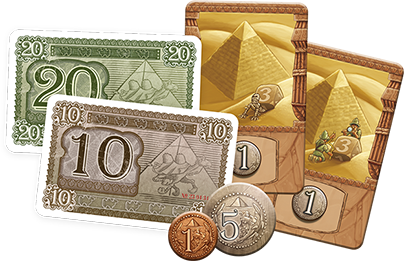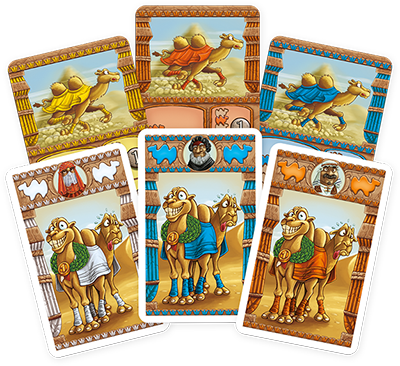Fancy taking a board game Bactrian to your place? Camel Up won’t give you the hump – its top of the pyramid.
In Camel Up two to eight players take on the role of eccentric Egyptian aristocrats, betting on camels racing around a pyramid. Whoever has the most money once one of the camels crosses the finish line wins. The game, which won the prestigious Spiel des Jahres in 2014, is designed for families and is both easy to learn and quick to play.
Mechanics
Camel Up introduces a unique stacking mechanic where both the turn order of the racing pieces and the distance they travel is very important. If a camel lands on a space occupied by another camel, it jumps on its back and hitches a free ride. This can lead to ridiculous racing towers of perfectly tessellating camels. It also adds a huge amount of unpredictability to the game – at any one point in a game the majority of camels could feasibly win the race.
Much of the fun and excitement comes from the unpredictability of the stacking mechanic. In my first game, the green camel looked like it was going to win from turn two, racing away from the rest of field. Fast forward 15 minutes, and the final moves of the game see the orange camel desperately catching green, and hopping onto its back.
Green then looks to sprint away, and just about gets to the finish line. But the free-riding orange camel stretches its neck out and crosses the line first (the camel on top of a stack always counts as being in front).
Winner, winner, (camel) dinner
But you’re not just betting on the overall winner - each race is broken down into legs, which end as soon as each camel has been moved. You earn almost as much money being the first to bet on the winning camel of each leg as you do by betting on the race winner. This is very clever as it means the whole race is hotly contested, rather than just the very end.
To get around the issue of live odds, Camel Up provides the first player to bet on the winner more money than the second player, who wins more than the third and so on. It works on the basis that clarity on the likely winner improves over time. The first player to place a bet on a camel is likely doing it with very little information and therefore should be receiving the longest odds.
Stacked against you
This works well most of the time. However it can simply reward the player who takes their turn after the player who likes to move the camels. As the first person able to respond to the improved clarity provided by a benefactor, the next player in line can cash in. This is only exacerbated in larger games with five or more players.
While we’re on the topic, one paltry gold for moving the camels doesn’t incentivise players to want to move the camels enough. Other players can win five gold plus from the extra information provided by a single camel's movement.
Finally, aside from placing bets or moving the camels, players can place an oasis or mirage on the race track. This provides the player with a gold coin every time a camel stack lands on it, and also allows players to influence movement on the board. A mirage forces camels backwards while an oasis allows them to move on an extra space.
Components
Camel Up is very well made – it doesn’t feel like a cheap game. The pyramid, an eye-catching but functional centrepiece, must be built from a few pieces of card and an elastic band. A DIY pyramid sounds dodgy, but it fits together so well, it’s almost as solid as the real thing. The card components are thick and robust, while the camels themselves are a joy to stack atop one another, tessellating perfectly.
Out of Africa
As I’ve lived in the Middle East, I have to point out that the Bactrian (two hump) camels used in the game and artwork are confined to Central Asia. Only the dromedary (single hump) lives in Egypt.
The two humps clearly tessellate better, but I’m a stickler for accurate geographic distribution (which probably says all you need to know about me).
Final thoughts on Camel Up
But it wouldn’t be pharaoh of me to make too much of any gripes I have with the game – it is a fun and well-made family-friendly game. It doesn’t have to be played with kids either, a little imagination and a crate of beers could quickly turn Camel Up into a drinking game.
It’s a great light game with some neat mechanics, and a worthy addition to any games collection. At a low price it’s also an absolute bargain.













